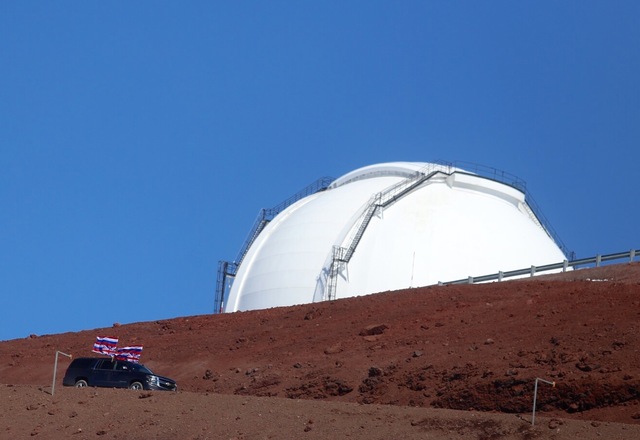Protesters of the Thirty Meter Telescope, who call themselves protectors of Mauna Kea, say they will continue to take a stand against the $1.4 billion project even if it means facing arrest. ADVERTISING Protesters of the Thirty Meter Telescope, who
Protesters of the Thirty Meter Telescope, who call themselves protectors of Mauna Kea, say they will continue to take a stand against the $1.4 billion project even if it means facing arrest.
Police officers warned the TMT opponents Tuesday that arrests would be made if they blocked the Mauna Kea Access Road again. Crews attempting to reach the construction site near the summit were blocked Monday by about 50 protesters who stood in their path outside the Mauna Kea visitor center.
Construction workers made no attempt Tuesday or Wednesday to reach the site, but TMT opponents say they were expecting that to change soon, possibly as early as today.
Kealoha Pisciotta, a TMT opponent who is one of the plaintiffs challenging the project in court, said none of the protesters are being asked to face arrest, but she expects plenty will do so voluntarily.
“People are willing to be arrested,” she said, adding about 100 protesters showed up at the visitor center Wednesday. “Many of those people came up today.”
Lanakila Mangauil, who has been on the mountain for most of the past week, said the protesters will continue to do what they can to keep construction equipment idle.
“For us, it’s the simple fact that machines are on the mountain, and if these people who operate the machines get on the machines, the mountain is going to start to be ripped up,” he said.
The TMT will be 180 feet tall and sit at the 13,150-foot elevation on the mountain’s north slope. A support building attached to the dome will cover about 18,000 square feet, according to the project’s environmental impact statement. A 0.6-mile road will lead to the site.
The state Board of Land and Natural Resources approved a sublease for the project covering about 6 acres last summer.
Mangauil said the TMT opponents think the project is in violation of conservation district regulations.
“We, the people of this land, are standing to uphold the law,” he said.
So far, courts have upheld the decision by BLNR to grant a conservation district use permit for the project. That included a contested case hearing and appeal to 3rd Circuit Court.
Plaintiffs have taken the matter to the state Intermediate Court of Appeals and also are challenging BLNR’s decision to grant the project a sublease.
The University of Hawaii responded to the protests by issuing a statement highlighting the seven-year review process and the project’s contribution to astronomy.
Among the claims the university said is inaccurate is that the project will harm the Mauna Kea aquifer and Hawaii Island’s drinking water.
“Comprehensive research by expert hydrologists confirms that TMT and the existing 13 telescopes pose no such danger,” UH said.
Several TMT opponents also met with Gov. David Ige on Wednesday after anti-TMT plaintiffs wrote him a letter asking him to put a stop to the project.
“We come to you with urgency in our hearts to ask for your help to protect the most revered place in our beloved archipelago, our highest mountaintop and land of our Akua, which is Mauna Kea,” the six plaintiffs wrote.
An Ige spokeswoman said in an email that the meeting helped “create a common understanding of the issues.” She didn’t say what his position is on the project.
TMT officials say they have the authority to proceed.
TMT will be one of the world’s most advanced telescopes when it achieves first light in 2024 and will collect nine times more light than any of the existing telescopes on the mountain.
According to its website, the observatory will explore with greater detail the creation of the universe, early galaxies, black holes and planets outside our solar system in addition to discoveries that can’t currently be anticipated.
Email Tom Callis at tcallis@hawaiitribune-herald.com.



